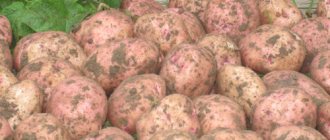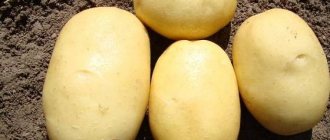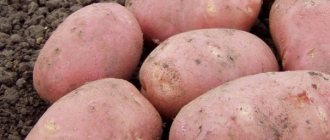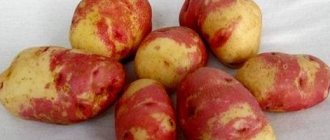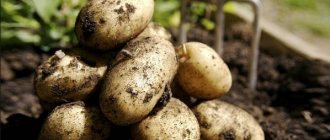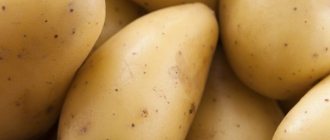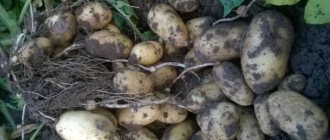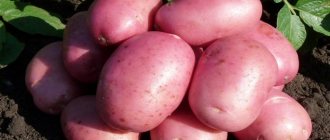Description of the potato variety Elizaveta
The Elizaveta potato variety was developed in the 90s in Russia. They say that it appeared due to the crossing of seven varieties of potatoes.
The bushes are low and compact. With deep green leaves. There are not many flowers and they all fall off quickly. Thanks to a well-developed root system, the plant produces many tubers.
It sprouts well from its own seeds and does not degenerate. This variety is famous for its high yield and good taste. In addition, it stores well.
Characteristics of potato tubers
The tubers are oval in shape, with milky pulp and a thin light brown skin. There are few eyes on potatoes and they are not clearly visible.
Depending on feeding, the weight of one tuber reaches 140 grams. With proper care, you can collect up to 15 tubers from one bush.
Potatoes are intended for eating; they do not disintegrate when cooked and keep their shape. The starch content in root vegetables ranges from 15-18%.
Ripening period
The ripening period depends on the growing region. Tubers typically mature approximately 70 days after planting. To enjoy young potatoes, they are dug up 20 days earlier.
Elizabeth's yield
The variety is famous for its high yield. The maximum you can collect is up to 550 kg per hundred square meters. And on average the yield is about 400 kg. With poor care or a suitable climate, fertility decreases by about 100 kg per hundred square meters.
Plant resistance to pests
The variety is resistant to nematodes, scab and other diseases. But with strong humidity it is susceptible to late blight and macrosporiosis of tubers and bushes. Although, due to the early ripening period, late blight almost does not take the plant by surprise, it is proposed to treat the bushes with preparations containing copper.
Signs of macrosporiosis on potato leaves
The main attack this variety is susceptible to is insects. From above it is overcome by the Colorado potato beetle, and from below by wireworms. Small numbers of beetles are removed by hand, and in case of large clusters, the plant is treated with special chemicals. But such treatment cannot be carried out less than 20 days before harvest. In order to combat wireworms, it is proposed to fight by removing grass and digging up the soil. You can learn about other ways to combat wireworms here.
Another good solution to the problem of insect control is to choose a new place to plant potatoes every year. This will increase the yield and reduce the risk of disease.
If black spots appear on the leaves of a plant, it is better to tear out the plant to avoid infecting other bushes. This is how late blight manifests itself - a disease that is difficult to cure.
Late blight on potatoes
For which regions is the Elizaveta potato variety suitable and climate requirements?
This variety is suitable for planting in the central regions of the Volga, the Far East, the North Caucasus, the Northern and Northwestern regions. But in general, Elizabeth potatoes adapt to different climates. It’s just that in the southern regions they harvest two crops per season.
Advantages and disadvantages
The main features of the variety include:
- excellent taste of root vegetables;
- high productivity;
- versatility of tubers;
- good commercial quality;
- the harvested crop is stored for a long time;
- resistance to major diseases.
No disadvantages were noticed in the variety. Productivity depends on climatic conditions and soil nutrition .
In the table below you can compare the characteristics of the Farmer variety with other very early varieties in terms of marketable weight of tubers and their keeping quality:
| Variety name | Weight of marketable tubers (grams) | Keeping quality |
| Elizabeth | 80-140 | 93% |
| Meteor | 100-150 | 95% |
| Minerva | 120-245 | 94% |
| Kiranda | 92-175 | 95% |
| Karatop | 60-100 | 97% |
| Veneta | 67-95 | 87% |
| Zhukovsky early | 100-120 | 92-96% |
| Riviera | 100-180 | 94% |
Reviews about potatoes Elizaveta
Basically, all gardeners speak well of the Elizaveta potato variety. It bears fruit well and is disease resistant. In the south, several harvests are harvested from it per season.
At the same time, gardeners try to adhere to the feeding and hilling schedule. Let's look at some reviews about Elizabeth potatoes.
https://zelenj.ru/sort-kartofelya-elizaveta-otzyvy.html
Alexandra, Simferopol
I have been using this potato variety for 10 years. From the very beginning I follow the watering and fertilizing regime. Every year I try to plant it in a new place. One year I decided to check how the harvest would change and left it in the same place. Basically, I didn’t notice much of a change. But I still prefer to follow all the measures for proper cultivation. I really like the taste, jacket potatoes are a common dish in our kitchen!
Kosteshin Victor, Samara
Previously, they mainly planted Lorch, but over time they switched to this variety. I like that Elizabeth is much more resistant to diseases and pests. There are no such problems with finding the necessary drugs for treatment. No changes were found in taste. At the same time, the potatoes ripen quickly. It’s very warm here, we try to harvest two crops in one year.
Alexandrova Elizaveta, Minsk
This year there was a heavy rainy season, so all the potatoes were infected with late blight. According to reviews, they believed that it can be grown twice a year. They planted it again around the end of June and harvested it at the beginning of September. Surprisingly, the harvest is much higher compared to the previous year. I'm very pleased with this variety!
Characteristic
The characteristics of the Elizabeth potato type are positive. The potatoes have proven themselves to be excellent. Mid-early variety, table variety. The yield is high, but depends on weather conditions during growth. Potatoes have good shelf life and do not spoil over the course of a couple of months. It also tolerates transportation well.
The fruits ripen all at the same time. They look beautiful, they are damaged, but not in large quantities. Potatoes Elizabeth are not demanding in care. It will grow well even with inexperienced farmers. He loves feeding and various fertilizers. The ripening period lasts 70-90 days. The first harvest is suitable for harvesting in summer. You can select your own seating material.
The Elizabeth variety has excellent characteristics, because the plant is not prone to most diseases. The variety is resistant to potato blight. The plant is rarely infected with blackleg, common scab and golden nematode. Late blight and wilt may appear, so gardeners should take preventive measures and monitor soil moisture.
Description of the plant
The bushes are small, straight and not branched. The leaves are green in color and not fibrous. The size is not large, the veins are clearly visible. When ripe, it produces white flowers.
The root system is also sufficiently formed. One bush produces approximately 10 fruits of high quality. Consequently, from 1 hectare of land it is possible to collect 290,000-400,000 kg. It all depends on the quality of the soil, growing conditions and care. Such facts are very important, since many of them significantly influence the taste characteristics and value of the variety.
Description of the fruit
Description of the potato variety Elizabeth - fruits of a yellow hue, with small eyes and smooth skin. One fruit weighs 80-140 g. The flesh is white and does not tend to turn black in the open air. Seed potatoes contain starch in a volume of 13-18%. Description Potatoes have many advantages, since the fruits contain a large amount of vitamins and amino acids.
Potatoes are ideal for sale because they have a beautiful appearance. Potatoes of the “Elizabeth” variety have a unique taste and do not contain dryness or water. The pulp does not turn black during cooking. Potatoes are suitable for preparing any dishes. It is also prepared for children, because it is absolutely harmless.
Pros and cons of the variety
Positive qualities include:
- great taste;
- greater fertility;
- marketable condition;
- storage and transportation of fruits;
- strong immunity.
There are practically no disadvantages, but its fertility depends on growing methods and weather conditions. Because of this, it is important to feed the plant on time.
Landing rules
First, planting material is selected and germinated until sprouts of 3-4 cm appear. To do this, 2 weeks before planting, the planting material is laid out in a lighted place and periodically moistened with water. This procedure is performed once every 3 days. After 2 weeks, sprouts of 3 cm should form on the tubers. We recommend material on how to prepare seed potatoes for planting.
Depending on the region, the planting date for potatoes varies. It is usually planted in April and May.
To plant potatoes, the soil must warm up to 10 degrees Celsius and the air to 15.
For planting, choose a well-lit place without shade. Before planting, it is recommended to fertilize the soil with mineral and organic fertilizers. Fertilizers with nitrogenous compounds are especially suitable. It’s good if you sowed buckwheat green manure in this place.
Buckwheat is an excellent predecessor to potatoes
If you plant potatoes in a new area every year, the yield will increase significantly. It is better if legumes or cabbage grew on it before the potatoes. You can plant oats, mustard or rapeseed a year before potatoes. These crops disinfect the land and additionally fertilize it. See other rules for planting potatoes.
After treating the tubers with humates, they are planted in the ground. The distance between the ridges is about 70 cm, and the distance between the tubers is 30 cm. In this case, the consumption will be approximately 24 kg. for 1 hundred. Potatoes are buried to a depth of 7 to 10 cm.
History of variety breeding
The Elizaveta variety is a long-standing representative of Russian selection, bred by scientists of the Leningrad Scientific Research Institute together with employees of the Volzhsk Breeding Station. The biological basis of this seven-species hybrid was S.vernei, S.phureja, S.acaule, S.demissum, S. stoloniferum, S.andigenum and the variety S.tuberosum. In 1996, potatoes were included in the state register of Russia as a mid-early table vegetable, recommended for cultivation in the Northern, Central, Western regions, the North Caucasus and Far Eastern regions of the state.
Did you know? Lebanese farmer Khalil Semhat managed to grow the largest vegetable tuber. The weight of the root crop was 11.2 kg.
Features of care
There are no unusual care features for this variety. They take care of it in the same way as others: they hill up, loosen the ground, weed, water and feed.
You need to hill up every two weeks. This will saturate the soil with oxygen, and therefore improve fruit growth.
Water thoroughly, but do not over-irrigate the foliage to avoid late blight. Usually watered when the tops reach a height of 15 cm, at the beginning of flowering and after. During this period, tubers are formed.
When it’s hot, water more often, but not more than once every five days. After watering, the soil is loosened and fertilizers are added.
According to gardeners, the Elizabeth potato variety loves loose soil; this will help to allow air to pass through the upper crusty layer of soil to the tubers. Covering the bushes with straw or mown grass helps prevent the formation of crust on the ground.
Fertilizing is carried out with mineral fertilizers during the emergence of sprouts, at the beginning and during flowering. Superphosphate is fertilized 2 weeks before digging the crop. The website has complete information about fertilizing potatoes.
How to properly care for the variety
After planting, you need to provide the potatoes with watering, fertilizing, loosening and hilling. Also, to get a good harvest, the plant must be protected from insects and pests.
Features of watering
Queen Elizabeth is classified as a moisture-loving variety, so the crop must be watered at least three times per season. The first time watering is carried out when the sprouts reach a height of about 20 cm, the second time during flowering and the third time after flowering has completed.
Hilling and weeding
After each watering or rain, it is recommended to loosen the soil and also remove any weeds that have appeared. The crop should be hilled three times a season. The first time, as soon as the tops grow to 20 cm in height, the second time after 14 days and the third time three weeks after the second hilling.
Diseases and pests of the Elizabeth potato variety
To combat the Colorado potato beetle, potatoes are sprayed with special chemical compounds. The beetles themselves are collected by hand. Some more ways to fight can be found here.
To combat macrosporiosis, bushes are sprayed with Bordeaux mixture, garlic infusion and a pink solution of potassium permanganate. A solution of potassium permanganate is also good for combating wireworms. To do this, the pink solution is poured into the ground. To combat wireworms, mustard is planted between the rows of potatoes. In addition, Mustard is an excellent green manure, i.e. fertilizes the soil well. Find out what green manure is and when to sow and bury Mustard.
What culture “loves”
Potato Elizabeth is an unpretentious variety to care for, but it has its own preferences in climate, soil and humidity.
Suitable climate
Elizabeth potatoes grow and develop well in any climatic conditions. It was bred for cultivation in northern regions. However, it produces high yields in temperate and southern regions.
Illumination, humidity and temperature conditions
Potatoes prefer well-lit areas, without drafts, with humidified air. Favorable air temperature for growth is 20 – 24 °C. Elizabeth is a moisture-loving variety; it needs to be provided with sufficient watering.
Required soil composition
Potatoes prefer light, loose soil with a drainage layer. Sandy and sandy loam soils are suitable; when growing in clay and loamy soils, it is recommended to add sand to the soil.
If the soil is highly acidic, it is necessary to add lime in the fall or spring in the form of fluff limestone, dolomite flour or chalk. Each type of soil has its own application rate; it is indicated on the packaging of the composition.
Favorable and Undesirable Neighbors
It is recommended to plant next to potato beds:
- Mustard. It repels the Colorado potato beetle.
- Oats. It enriches the soil with nitrogen.
- Pumpkin and zucchini. They enrich the soil with nitrogen and cleanse it.
- Cucumbers. Do not affect potato growth.
Unfavorable crops for potatoes are members of the nightshade family and vegetables that form root crops.
These include:
Harvest and storage
Harvesting the Elizabeth potato begins after the tops of the plant begin to dry. Before digging, it is suggested to cut off the tops so that they do not spread late blight.
Also, mowing the tops helps to coarsen the skin of the tubers, which has a positive effect on storage.
After digging, the potatoes should be left to dry in the shade for 4 hours. It is good if the room is ventilated.
Store potatoes at a temperature of 3-5 degrees Celsius in a dry, ventilated area.
